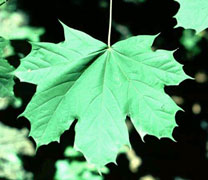


Home
Flowers &
Indoor Plants
Fruits & Nuts
Ornamentals
Vegetables
Special Topics
Resources
Glossary

|
Norway Maple Acer platanoides (ay-sir pla-tah-noy-teez)    Click on thumbnails for larger image. |
 |
What about it? The Norway maple is a large deciduous tree with opposite leaves and buds. (Remember MADHORSE for the trees with opposite branching: maples, ashes, dogwoods, and horsechesnuts.) Maples usually grow to a height of 50 to 60 feet. People are always searching for easy ways to differentiate between maple species. Sometimes generalizations can be made about their leaves. Norway maples typically have leaves that are broader than they are high. They also have 5 prominent lobes and are bright green on both sides. When leaves are torn from the twigs a milky sap will ooze out- but don't tear off leaves just for fun! Norway maples have dark gray bark with many furrows and leaves that will turn yellow in the late fall. What is it used for? Since the Norway maple has such dense foliage, it is typically used as a shade tree, either in lawns or on streets. Where does it grow? How do we grow it? Norway maples will grow anywhere in the United States. They are tolerant of difficult growing sites and will grow in even the coldest areas. Because of this hardiness, Norway maples are one of the most common maples planted and there are numerous varieties available. What are its primary problems? One of its great attributes leads to ane of its difficulties however. Because it provides a great deal of shade (and it has very shallow roots), it is nearly impossible to grow grass or other plants beneath a Norway maple. Also, Norway maples are heavy seeders- you will see the little "helicopters" or double samaras littering the yard. As for pests and diseases, the Norway maple is susceptible to Verticillium wilt and aphids. Anthracnose can be a problem during wet seasons.
© Copyright, Department of Horticulture, Cornell University. |